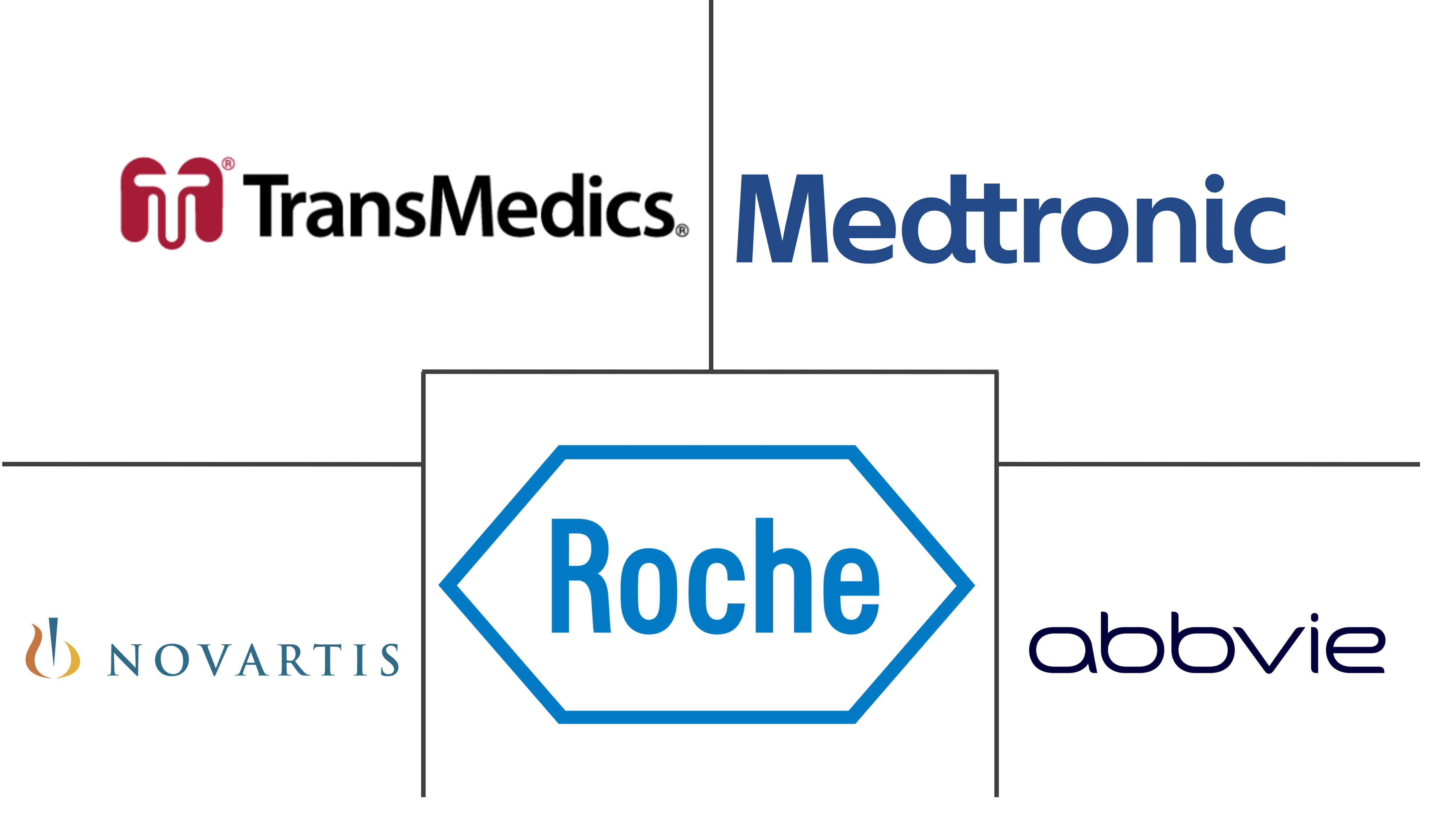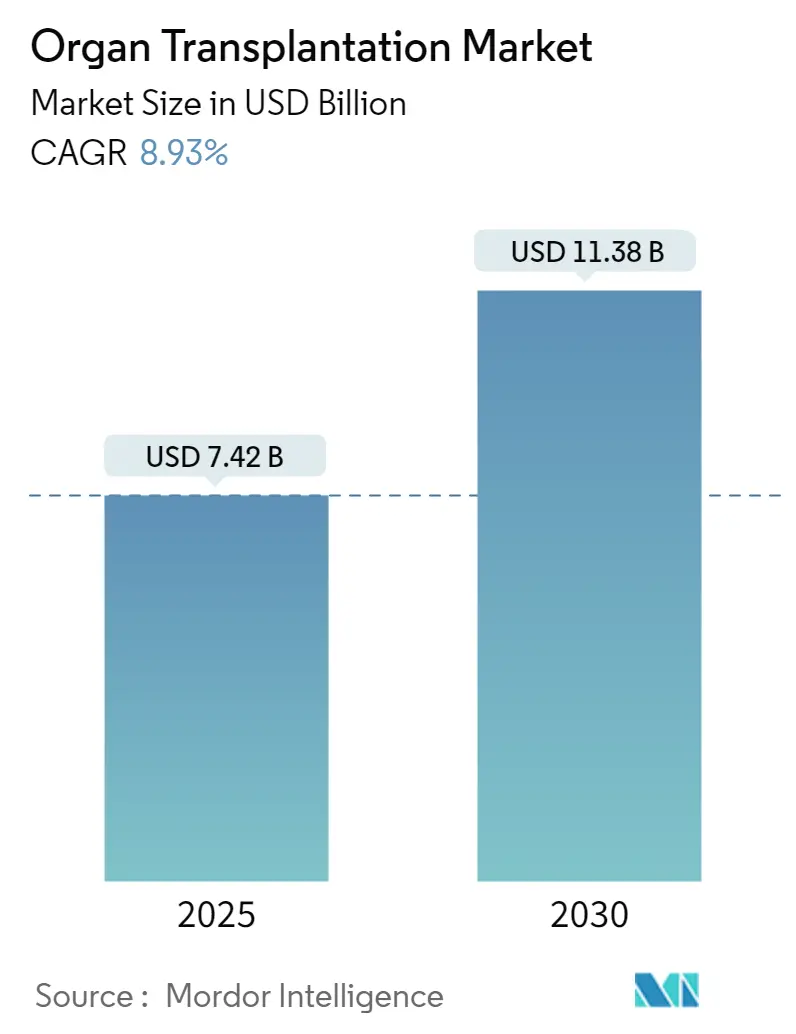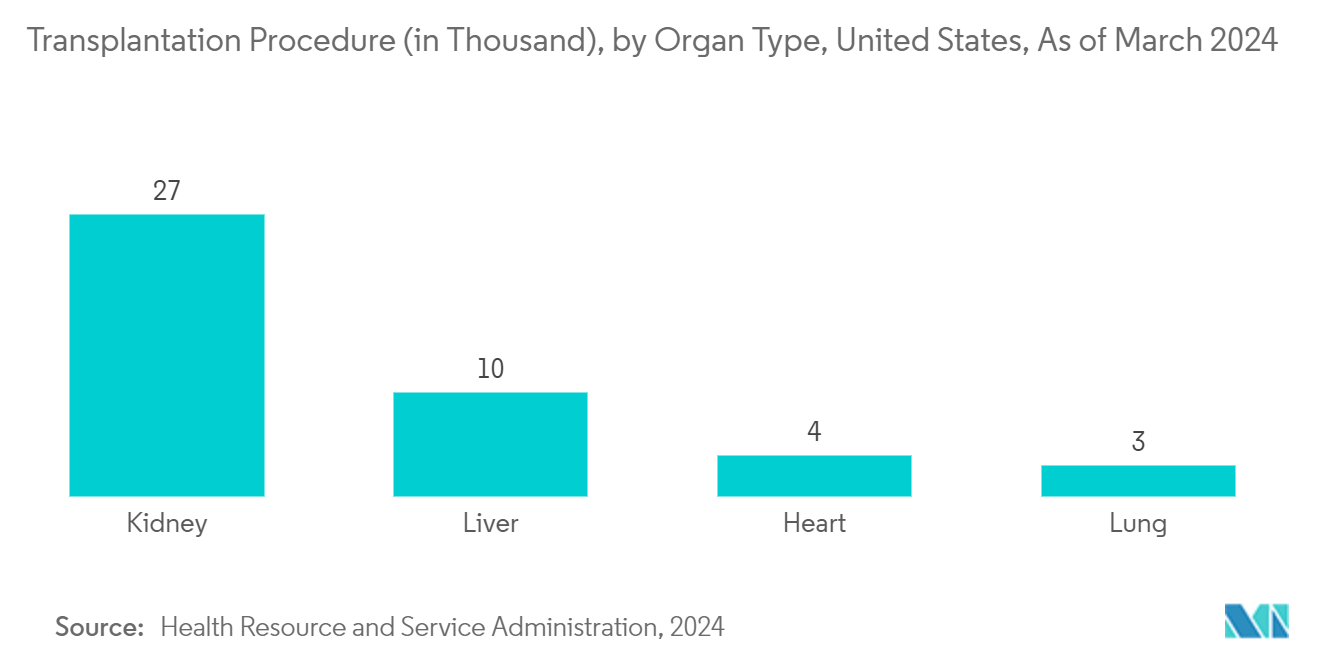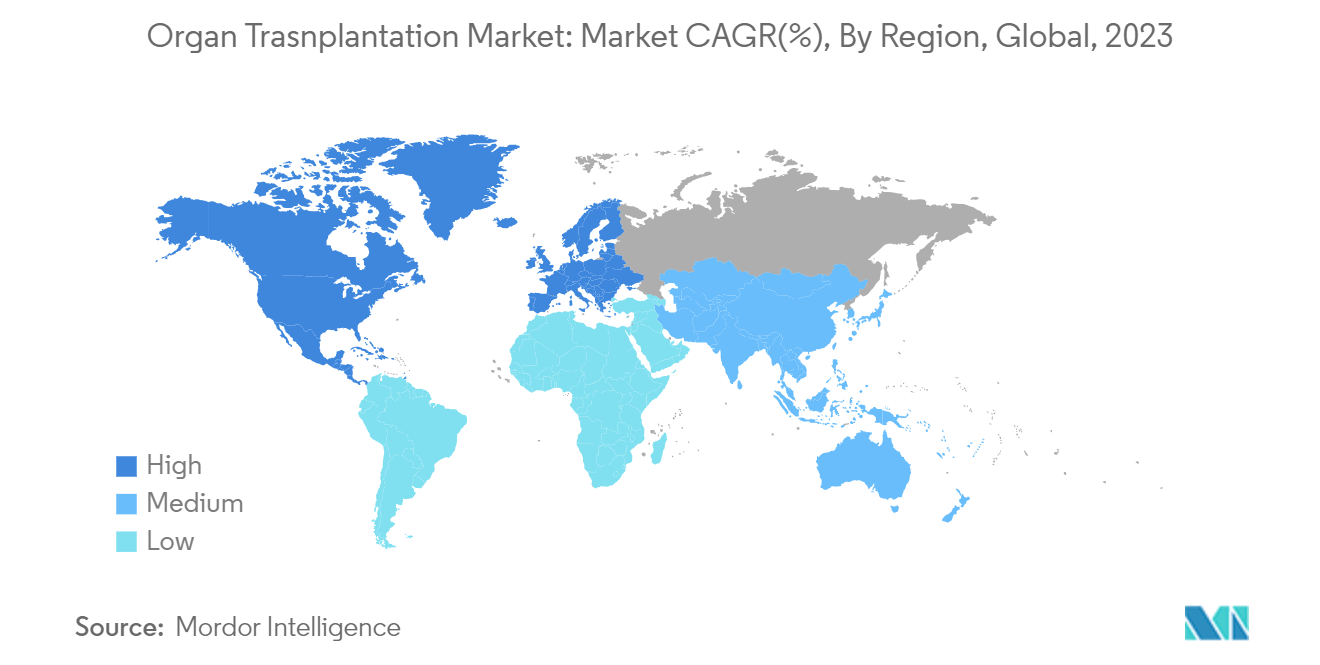Organ Transplantation Market Analysis
The Organ Transplantation Market size is estimated at USD 7.42 billion in 2025, and is expected to reach USD 11.38 billion by 2030, at a CAGR of 8.93% during the forecast period (2025-2030).
Factors such as the increasing number of organ transplants due to chronic diseases, technological advancements in tissue engineering and organ transplantations, and rising awareness and government initiatives for organ donation and transplantation are expected to boost the growth of the organ transplantation market over the forecast period.
The growing burden of various kidney-related health conditions has been on the rise in recent years. The rising prevalence of kidney diseases such as kidney failure and end-stage renal diseases necessitates kidney transplantation procedures, which propel the demand for various products used during transplantation procedures, thereby bolstering market growth. For instance, as per the Chronic Kidney Disease Registry’s report in March 2024, the prevalence of chronic kidney diseases among the Indian population is increasing rapidly, with the majority of people diagnosed with stage 4 and stage 5 kidney diseases. Thus, the significant burden faced by patients with kidney disease underscores the necessity for kidney transplants, propelling the market’s growth.
Additionally, the high number of organ transplant procedures performed worldwide is anticipated to augment the demand for preservation solutions, immunosuppressant drugs, and other related products in the market, which is expected to augment market growth over the forecast period. For instance, according to data published by XVIVO Perfusion in its 2023 annual report, approximately 160,000 organ transplants are carried out annually worldwide, which unfortunately only corresponds to 10% of the total requirement. Kidney transplants have been shown to generate significant cost savings for healthcare providers. This data demonstrates the high demand for kidney transplantation procedures among the population, propelling market growth.
Similarly, according to data published by the National Organ and Tissue Transplant Organization (NOTTO) in August 2024, about 18,378 organ transplants were performed in India in 2023. Notably, 10% of these procedures were for foreign nationals seeking treatment in India, and over 60% of the living organ donors were women.
In addition to the above context, India's deceased-donor transplants reached 2,935 in 2023, a significant leap from just 837 a decade ago. The state of Rajasthan, with 116 transplants catering to foreign nationals, secured the first position, trailed by West Bengal with 88 transplants. Given this upward trajectory in organ transplantation procedures, the demand for associated products is poised to rise, further driving market growth.
Moreover, government and NGO initiatives to raise public awareness bridge the organ demand-supply gap, ultimately saving more lives through organ donation. These efforts are poised to boost the demand for organ transplantation procedures and related products, driving market growth during the forecast period. For instance, in February 2024, Assam's government introduced the Sushrusha Scheme, offering INR 1 lakh (USD 1,195.86) in financial aid to kidney transplantation patients. These initiatives not only ease the financial strain on patients and their families but also enhance access to organ transplantation. Similarly, the Indian government rolled out awareness campaigns like "Angdaan Mahotsav" and "Organ Donation Month" in July 2023, underscoring the push for organ donation. Such programs are set to amplify organ transplantation procedures and further fuel market expansion.
Similarly, in March 2024, the new National Health Service (NHS) and government partnered to boost organ donation registration in the United Kingdom. Thus, rising partnership activities between the government and health services increase the availability of organs, improve public awareness, and improve infrastructure. These factors are expected to contribute to the growth of the organ transplantation market over the forecast period.
Therefore, owing to the rising burden of kidney-related health conditions, increasing organ transplantation procedures, and growing government initiatives, the market studied is expected to grow over the forecast period. However, the high cost of transplantation, low availability of organs, and rejection issues are likely to impede the growth of the market over the forecast period.
Organ Transplantation Market Trends
Immunosuppressant Drugs Segment Expected to Witness Significant Growth Over the Forecast Period
Immunosuppressant drugs play a crucial role in organ transplantation, safeguarding the transplanted organ from rejection by the recipient's immune system. Key categories of these drugs include calcineurin inhibitors, antiproliferative agents, mTOR inhibitors, monoclonal antibodies, and corticosteroids. Segment growth is anticipated due to factors like the increasing number of organ transplants, heightened organ rejection risks, advancements in immunosuppressant therapies, and ongoing research and development activities into novel and combination immunosuppressant drugs.
Calcineurin inhibitors (CNIs) are foundational to renal transplant immunosuppression. Cyclosporine A (CSA) and tacrolimus (TAC), the two primary CNIs, have been integral for kidney transplant recipients for over two decades. Numerous studies have assessed the safety and efficacy of these drugs in organ transplants. For instance, a November 2023 article published in the National Library of Medicine highlighted that cyclosporine, an FDA-approved adjuvant, effectively prevents allogenic organ transplant rejection when combined with glucocorticoids. This finding has been especially relevant for patients undergoing kidney, heart, liver, and bone marrow transplants. Given the proven efficacy of calcineurin inhibitors in organ transplant patients, their prominence in the market is set to grow.
Additionally, researchers are actively developing novel immunosuppressant drugs, further driving their demand in organ transplantation and fueling the segment’s growth. For instance, in August 2023, Duke Health researchers reported that AT-1501, a synthetic monoclonal antibody, successfully prevented organ rejection in primate kidney transplant tests. Notably, this was achieved without needing extra immunosuppressive drugs or causing blood clots. The findings endorsed AT-1501 as both safe and effective for enhancing islet and kidney transplant survival and function. Such breakthroughs are likely to accelerate the market introduction of new immunosuppressant drugs.
Furthermore, the rise of monoclonal antibodies and immune-targeting drugs could amplify the demand for immunosuppressants in organ transplants. For instance, in March 2024, Eledon Pharmaceuticals Inc. highlighted the use of tegoprubart, an experimental anti-CD40L antibody, in the groundbreaking transplant of a kidney from a genetically modified pig to a human. Multiple studies have validated tegoprubart's safety and tolerability, especially in preventing kidney transplant rejection. Such developments are expected to spur market growth over the forecast period.
Therefore, owing to factors such as the rising number of research studies related to the safety and effectiveness of immunosuppressant drugs in organ transplantation and new product launches by key players, the segment studied is expected to grow over the forecast period.
North America Expected to Hold a Significant Market Share Over the Forecast Period
North America is poised for substantial growth during the forecast period, driven by a surge in transplant procedures, a rising prevalence of chronic conditions necessitating organ transplants, and the region's supportive reimbursement policies. Furthermore, bolstered by heightened government investments, proactive initiatives, and new product introductions by major players, the market is set to expand over the forecast period.
The prevalence of kidney-related health conditions has surged over recent years. As conditions like kidney failure and end-stage renal diseases become more common, the demand for kidney transplantation procedures rises, subsequently boosting the market for related products. For instance, a modeling analysis published by AstraZeneca in April 2024 highlighted that approximately 16.5% of the population in eight countries, including the United States, totaling 125 million people, are projected to be affected by chronic kidney disease (CKD). This marks a 25% increase since 2022, with advanced-stage cases potentially escalating by nearly 60% by 2032. Such numbers emphasize the growing burden of kidney diseases and the increasing need for kidney transplants, hence driving market expansion.
The rising number of organ transplantation procedures is set to drive market growth during the forecast period. For instance, data released by the Health Resources and Services Administration in January 2024 revealed that the United States witnessed approximately 46,632 organ transplants from both living and deceased donors in 2023. This marked an 8.7% increase over 2022.
In addition to the above, out of the total 46,632, 39,679 organ transplants were sourced from deceased donors in the United States in 2023, reflecting an 8.9% increase over the previous year. Consequently, as organ transplantation procedures become more prevalent, there is a burgeoning demand for organ preservation, diagnostics, and immunosuppressant drugs, which is anticipated to fuel market growth.
Furthermore, government initiatives, including investments in organ transplantation and procurement programs, as well as efforts to raise awareness about organ transplantation procedures, are poised to drive market growth in the coming years. For instance, in March 2023, the US Department of Health and Human Services invested about USD 36 million for organ procurement and transplantation, bringing the total to USD 67 million for Fiscal Year 2023. Similarly, in February 2024, Health Canada collaborated with the Organ Donation and Transplantation Network to enhance organ and tissue donation and transplantation efforts. These initiatives are anticipated to boost the demand for organ and tissue donations, subsequently elevating the need for organ preservation solutions, transplantation products, diagnostic devices, and related drugs in the market.
Additionally, as companies ramp up organ transplantation procedures and introduce related products, the market is set for growth. For instance, in April 2024, United Therapeutics Corporation achieved a milestone by transplanting its produced UThymoKidney into a living recipient. This transplant was authorized by the Food and Drug Administration under the expanded access pathway. The UThymoKidney is a pioneering investigational xenokidney derived from a pig, featuring a single genetic edit and supplemented with tissue from the pig’s thymus.
In February 2024, Bridge to Life Ltd reintroduced its organ preservation solution, EasiSlush, in the United States. EasiSlush's user-friendliness and efficiency position it as a crucial asset for healthcare professionals, emphasizing its role in saving lives. Such advancements are set to amplify demand for organ preservation products, propelling market growth.
Therefore, owing to the growing burden of kidney-related health conditions, increasing number of organ transplant procedures, growing government investments and initiatives to promote organ and tissue donation and transplantation procedures, and rising organ transplant procedures, coupled with new product launches by key players, the market studied is expected to grow over the forecast period.
Organ Transplantation Industry Overview
The organ transplantation market is fragmented due to the presence of many key players. The smaller key players in the market are involved in various aspects, such as organ preservation, transportation, and transplant medications. Some of the key players in the market are Novartis AG, AbbVie Inc., F. Hoffmann-La Roche Ltd, Medtronic, and TransMedics Inc.
Organ Transplantation Market Leaders
-
Novartis AG
-
AbbVie Inc.
-
TransMedics, Inc.
-
F. Hoffmann-La Roche Ltd
-
Medtronic
- *Disclaimer: Major Players sorted in no particular order
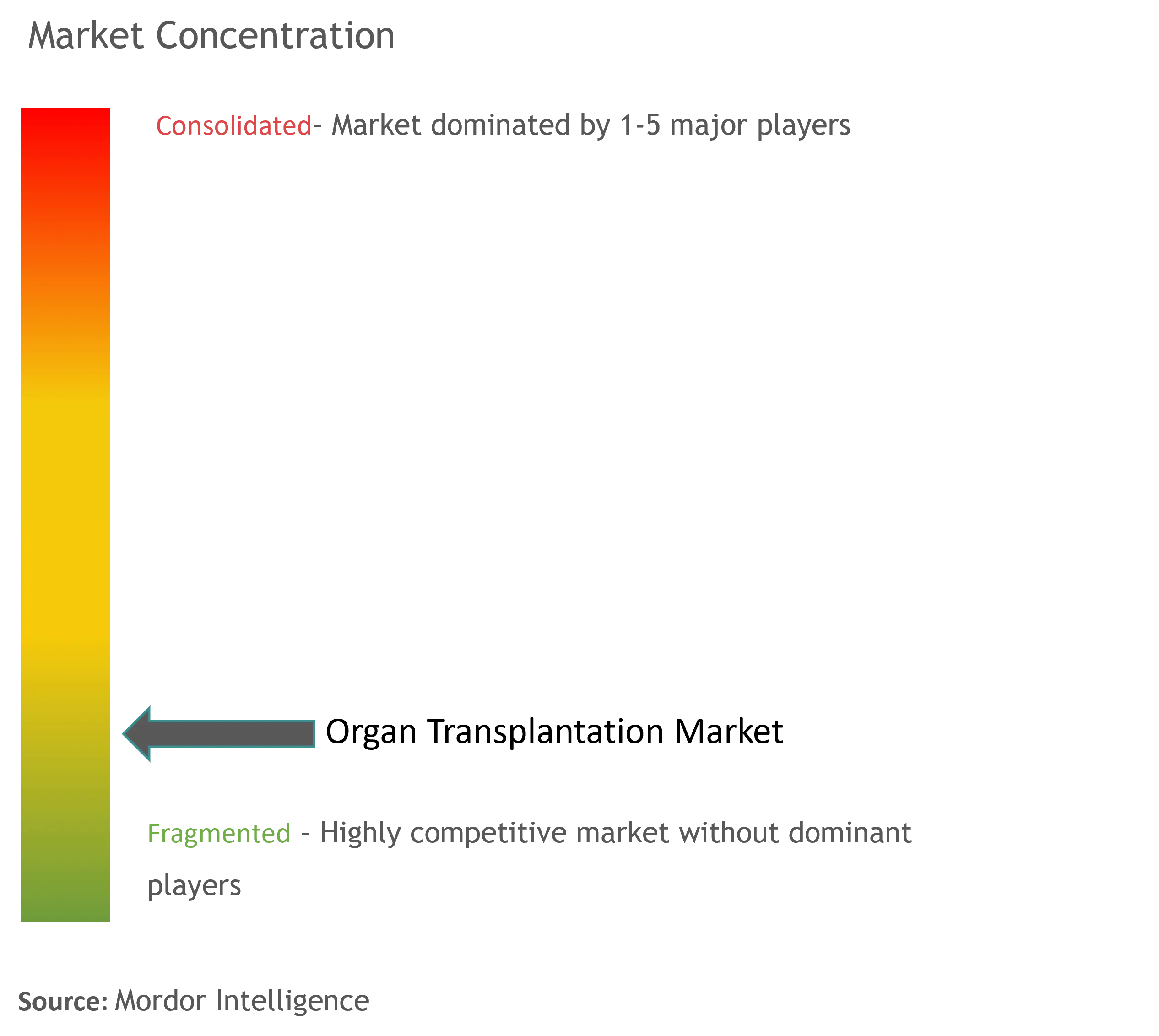
Organ Transplantation Market News
- August 2024: Getinge signed an agreement to acquire 100% of Paragonix Technologies Inc., a premier US-based company specializing in organ transport products and services, for USD 477 million. By acquiring Paragonix Technologies, Getinge stepped into a rapidly evolving domain spurred by increasing transplant volumes, technological advancements, and changing clinical practices. The acquisition aligned with Getinge's overarching strategy to broaden its portfolio in high-growth markets. These markets not only complement but also bolster Getinge's existing acute heart and lung support offerings.
- July 2024: The State Government of Kerala, India, established an Institute of Organ and Tissue Transplant as an Apex Institute for research, training, and patient care in the area of organ transplantation and allied activities at Kozhikode.
Organ Transplantation Industry Segmentation
As per the scope of the report, organ transplantation is a medical procedure that involves the removal of an organ from one body (the donor) and its implantation into the recipient body. Commonly transplanted organs include the heart, kidneys, liver, lungs, and pancreas. Organ transplantation procedures significantly improve the quality of life and survival rate for patients with end-stage organ failure.
The organ transplantation market is segmented by organ type, type of transplant, product type, end user, and geography. By organ type, the market is segmented into kidney, liver, heart, pancreas, and other organ types. The other organ types segment includes intestine and lungs. By type of transplant, the market is segmented into allogenic, autologous, and other types of transplants. The other types of transplants segment includes allograft, xenotransplants, and composite tissue transplants. By product type, the market is segmented into organ preservation products, transplant diagnostics, immunosuppressant drugs, tissue products, and other product types. The other product types segment includes telemedicine solutions and patient management tools. By end user, the market is segmented into hospitals, transplant centers, and other end users. The other end users segment includes outpatient clinics and ambulatory surgical centers. By geography, the market is segmented into North America, Europe, Asia-Pacific, Middle East and Africa, and South America. For each segment, the market sizes and forecasts have been done based on value (USD).
| By Organ Type | Kidney | ||
| Liver | |||
| Heart | |||
| Pancreas | |||
| Other Organ Types (Intestine, Cornea, and Lungs) | |||
| By Type of Transplant | Allogenic | ||
| Autologous | |||
| Other Types of Transplants (Allograft, Xenotransplants, and Composite Tissue Transplants) | |||
| By Product Type | Organ Preservation Products | ||
| Transplant Diagnostics | |||
| Immunosuppressants Drugs | |||
| Tissue Products | |||
| Other Product Types (Telemedicine Solutions and Patient Management Tools) | |||
| By End User | Hospitals | ||
| Transplant Centers | |||
| Other End Users (Outpatient Clinics and Ambulatory Surgical Centers) | |||
| Geography | North America | United States | |
| Canada | |||
| Mexico | |||
| Europe | Germany | ||
| United Kingdom | |||
| France | |||
| Italy | |||
| Spain | |||
| Rest of Europe | |||
| Asia-Pacific | China | ||
| Japan | |||
| India | |||
| Australia | |||
| South Korea | |||
| Rest of Asia-Pacific | |||
| Middle East and Africa | GCC | ||
| South Africa | |||
| Rest of Middle East and Africa | |||
| South America | Brazil | ||
| Argentina | |||
| Rest of South America | |||
Organ Transplantation Market Research FAQs
How big is the Organ Transplantation Market?
The Organ Transplantation Market size is expected to reach USD 7.42 billion in 2025 and grow at a CAGR of 8.93% to reach USD 11.38 billion by 2030.
What is the current Organ Transplantation Market size?
In 2025, the Organ Transplantation Market size is expected to reach USD 7.42 billion.
Who are the key players in Organ Transplantation Market?
Novartis AG, AbbVie Inc., TransMedics, Inc., F. Hoffmann-La Roche Ltd and Medtronic are the major companies operating in the Organ Transplantation Market.
Which is the fastest growing region in Organ Transplantation Market?
Asia Pacific is estimated to grow at the highest CAGR over the forecast period (2025-2030).
Which region has the biggest share in Organ Transplantation Market?
In 2025, the North America accounts for the largest market share in Organ Transplantation Market.
What years does this Organ Transplantation Market cover, and what was the market size in 2024?
In 2024, the Organ Transplantation Market size was estimated at USD 6.76 billion. The report covers the Organ Transplantation Market historical market size for years: 2019, 2020, 2021, 2022, 2023 and 2024. The report also forecasts the Organ Transplantation Market size for years: 2025, 2026, 2027, 2028, 2029 and 2030.
Organ Transplantation Industry Report
Statistics for the 2025 Organ Transplantation market share, size and revenue growth rate, created by Mordor Intelligence™ Industry Reports. Organ Transplantation analysis includes a market forecast outlook for 2025 to 2030 and historical overview. Get a sample of this industry analysis as a free report PDF download.

